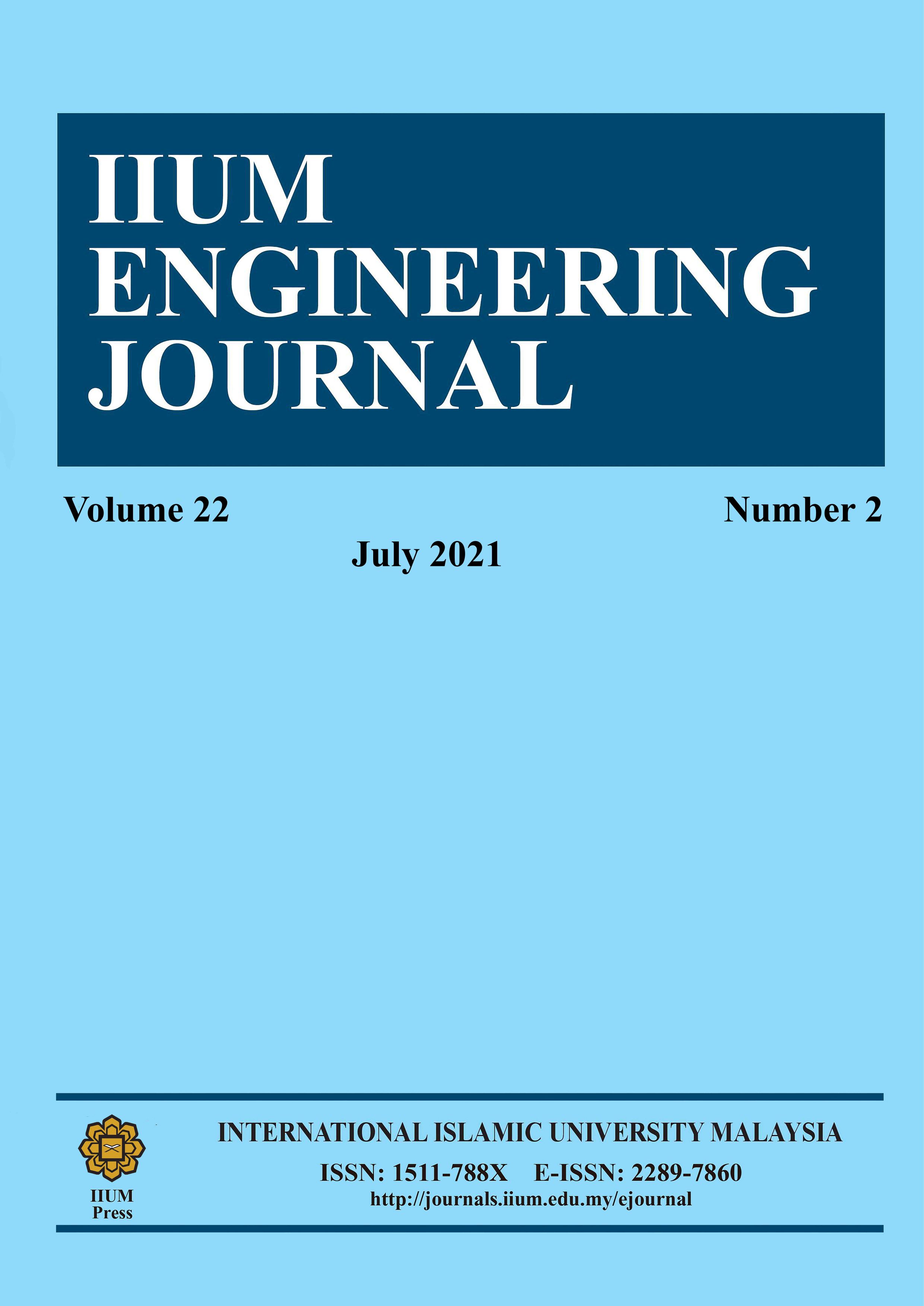POTENTIAL OF FABRICATION OF DURIAN SKIN FIBER BIOCOMPOSITES FOR FOOD PACKAGING APPLICATION THROUGH THE ELECTRICITY IMPACT ANALYSIS
DOI:
https://doi.org/10.31436/iiumej.v22i2.1673Keywords:
life cycle assestment, cradle-to-grave, durian skin fiber, plasticizer, food packaging, polylactic acidAbstract
As an effort to replace the petroleum-based polymers and reduce waste-related environmental problems, biopolymers are the best candidate due to their renewable, biodegradable and commercially viable. Initiative have been taken by developing durian skin fibre (DSF) reinforced polylactic acid (PLA) biocomposites with the addition of epoxidized palm oil (EPO). PLA/DSF biocomposites were fabricated via extrusion and then injection moulded. The biocomposites were assessed for its life cycle by developing a system boundary related to its fabrication processes using GaBi software. The life cycle assessment (LCA) of PLA/DSF biocomposites show that global warming potential (GWP) and acidification potential (AP) were the major impacts from PLA/DSF biocomposite. For PLA/DSF biocomposite, the results were 199.37 kg CO2 equiv. GWP and 0.58 kg SO2 equiv. AP. Meanwhile, for PLA/DSF/EPO biocomposite, the results obtained were 195.89 kg CO2 equiv. GWP and 0.57 kg SO2 equiv. AP. The GWP and AP were contributed by the electricity used in the fabrication of biocomposites. These impacts were due to the usage of electricity, which contributed to the emission of CO2. However, the PLA/DSF/EPO biocomposite had lower negative impacts because EPO improved the workability and processability of the biocomposite, and hence, reduced the amount of energy required for production. It can be concluded that the plasticized PLA/DSF biocomposite can be a potential biodegradable food packaging material as it has favourable properties and produces no waste.
ABSTRAK: Biopolimer adalah terbaik dalam usaha mengganti polimer berasaskan-petroleum dalam mengurang masalah pencemaran-sisa. Ini kerana biopolimer boleh diperbaharui, biodegradasi dan sangat maju secara komersial. Inisiatif telah diambil dengan menghasilkan sabut kulit durian (DSF) bersama biokomposit asid polilaktik (PLA) dengan penambahan minyak kelapa sawit terepoksi (EPO). Biokomposit PLA/DSF direka melalui kaedah pemyemperitan dan acuan suntikan. Biokomposit ini dipantau kitar hidupnya dengan membina sistem sempadan berkaitan proses rekaan menggunakan perisian GaBi. Pengawasan kitar hidup (LCA) biokomposit PLA/DSF menunjukkan potensi pemanasan global (GWP) dan potensi pengasidan (AP) menyebabkan impak terbesar komposit PLA/DSF. Dapatan kajian menunjukkan 199.37 kg CO2 bagi GWP dan 0.58 kg SO2 bagi AP bagi biokomposit PLA/DSF. Sementara itu, dapatan kajian bagi biokomposit PLA/DSF/EPO adalah 195.89 kg CO2 bagi GWP dan 0.57 kg SO2 bagi AP. Kedua-dua GWP dan AP adalah disebabkan oleh penggunaan elektrik dalam proses pembuatan biokomposit. Ini adalah kesan daripada penggunaan elektrik, dan menyumbang kepada pembebasan CO2. Walau bagaimanapun, biokomposit PLA/DSF/EPO mempunyai kurang kesan negatif, kerana EPO telah menambah baik kebolehkerjaan dan kebolehprosesan biokomposit, menyebabkan kurang tenaga yang diperlukan dalam proses pembuatan. Kesimpulannya plastik biokomposit PLA/DSF berpotensi sebagai bahan biodegradasi bagi pembungkus makanan kerana ianya mempunyai ciri-ciri yang diperlukan dan tidak menghasilkan sisa buangan.
Downloads
Metrics
References
Duncan TV. (2011) Applications of nanotechnol. in food packaging and food safety: barrier materials, antimicrobials and sensors. J. of Colloid and Interface Science, 363: 1-24.
https://doi.org/10.1016/j.jcis.2011.07.017 DOI: https://doi.org/10.1016/j.jcis.2011.07.017
Siracusa V. (2012) Food packaging permeability behaviour: A report. Int. J. of Polym. Sci., 1-11. https://doi.org/10.1155/2012/302029 DOI: https://doi.org/10.1155/2012/302029
Badmus AA, Gauri S, Ali NI, Gomes C. (2015) Mechanical stabilty of biobased food packaging materials. Food Sci. and Quality Management, 39: 41-48.
Xu X, Jayaraman K, Morin C, PecqueuxN. (2008) Life cycle assess of wood-fibre-reinforced polypropylene composites. J of Mater. Processing Tech., 198: 168-177. https://doi.org/10.1016/j.jmatprotec.2007.06.087 DOI: https://doi.org/10.1016/j.jmatprotec.2007.06.087
ISO, 2006a. ISO 14040: Environmental management - life cycle asses. – princ. and framew. Int Organization for Standardization, Genève, Switzerland.
ISO, 2006b. ISO 14044: Environmental management - life cycle assess. – princ. and framew. Int. Organization for Standardization, Genève, Switzerland.
Subramaniam V, May CY, Muhammad H, Hashim Z, Tan YA, Wei PC. (2010) Life cycle assess.of the production of crude palm oil (part 3). J. of Oil Palm Research, 22: 895-903.
Schmidt JH. (2010) Comparative life cycle assess. of rapeseed oil and palm oil. The Int J. of Life Cycle Assess., 15: 183-197. DOI: https://doi.org/10.1007/s11367-009-0142-0
Flynn HC, Canals LMI, Keller E, King H, Sim S, Hastings A, Smith P. (2012) Quantifying global greenhouse gas emissions from land-use change for crop production. Global Change Biology, 18: 1622-1635. https://doi.org/10.1111/j.1365-2486.2011.02618.x DOI: https://doi.org/10.1111/j.1365-2486.2011.02618.x
Choo YM, Muhamad H, Hashim Z, Subramaniam V, Puah CW, Tan Y. (2011) Determination of GHG contributions by subsystems in the oil palm supply chain using the LCA approach. The Int. J. of Life Cycle Assess., 16: 669-681. DOI: https://doi.org/10.1007/s11367-011-0303-9
Vink ETH, Davies S. (2015). Life cycle inventory and impact assessment data for 2014 IngeoTM polylactide production. Industrial Biotechnology, 11: 167-180. https://doi.org/10.1089/ind.2015.0003 DOI: https://doi.org/10.1089/ind.2015.0003
Jusoh ER, Ismail MH, Abdullah LC, Robiah Y, Rahman WAWA. (2012) Crude palm oil as a bioadditive in polypropylene blown films. Bioresources, 7: 859-867.
Sanyang ML, Sapuan SM, Jawaid M, Ishak MR, Sahari J. (2016) Effect of plasticizer type and concentration on physical properties of biodegradable films based on sugar palm (Arenga pinnata) starch for food packaging. J. of Food Sci. and Tech., 53: 326–336. DOI: https://doi.org/10.1007/s13197-015-2009-7
Zaid SM, Myeda NE, Mahyuddin N, Sulaiman R. (2015) Malaysia’s rising GHG emissions and carbon 'lock-in' risk?: A review of Malaysian building sector legislation and policy. J. of Surv., Construction and Property, 6: 1-1. DOI: https://doi.org/10.22452/jscp.vol6no1.1
Abdullah WSW, Osman M, Ab Kadir MZA, Verayiah R. (2019) The Potential and Status of Renewable Energy Development in Malaysia. Energies, 12(2): 2437.
https://doi.org/10.3390/en12122437 DOI: https://doi.org/10.3390/en12122437
Samsudin MSN, Rahman MM, Wahid MA. (2016) Power generation sources in Malaysia?: Status and prospects for sustainable development. J. of Adv. Review on Sci. Research, 25: 11-28.
Jungbluth N. (2006) Comparison of the environmental impact of tap water vs. bottled mineral water. Uster, Switzerland: Swiss Gas and Water Association Bull.
Hervy M, Evangelisti S, Lettieri P, Lee KY. (2015) Life cycle assess. of nanocellulose-reinforced advanced fibre composites. Composites Sci. and Tech., 118: 154-162. https://doi.org/10.1016/j.compscitech.2015.08.024 DOI: https://doi.org/10.1016/j.compscitech.2015.08.024
Ortiz-Reyes E, Anex RP. (2018) A life cycle impact assess. method for freshw. eutrophication due to the transp. of phosphorus from agricultural production. J. of Cleaner Production, 177: 474-482. DOI: https://doi.org/10.1016/j.jclepro.2017.12.255
de Jonge VN, Elliott M. (2001) Eutrophication. Encyclopedia of Ocean Sciences, 2: 852-870. DOI: https://doi.org/10.1006/rwos.2001.0047
La Rosa AD, Recca G, Summerscales J, Latteri A, Cozzo G, Cicala G. (2014) Bio-based versus traditional polymer composites. A life cycle assessment perspective. J. of Cleaner Production, 74: 135-144. https://doi.org/10.1016/j.jclepro.2014.03.017 DOI: https://doi.org/10.1016/j.jclepro.2014.03.017
Downloads
Published
How to Cite
Issue
Section
License
Copyright (c) 2021 IIUM Press

This work is licensed under a Creative Commons Attribution-NonCommercial 4.0 International License.






















